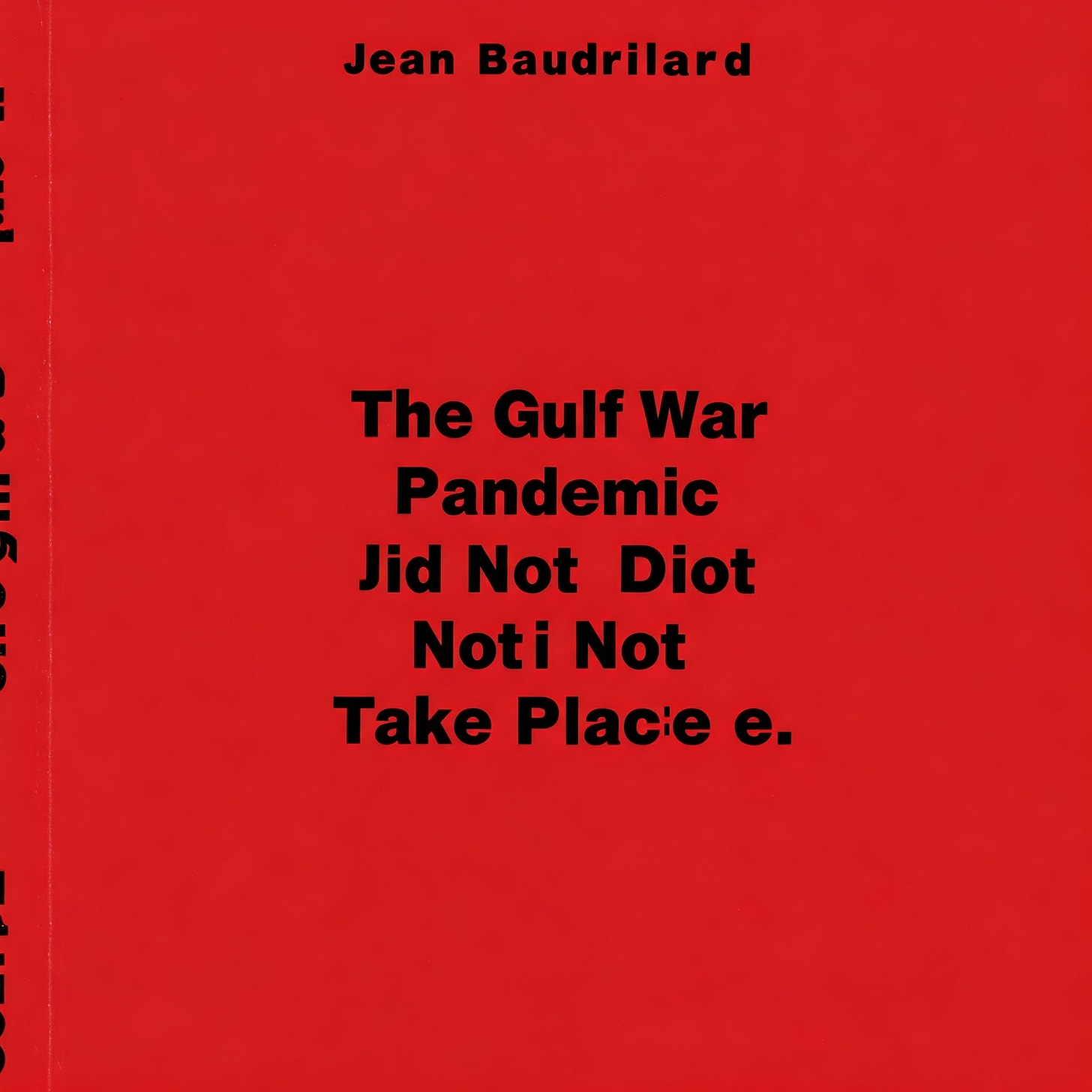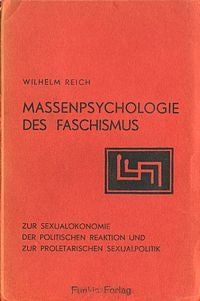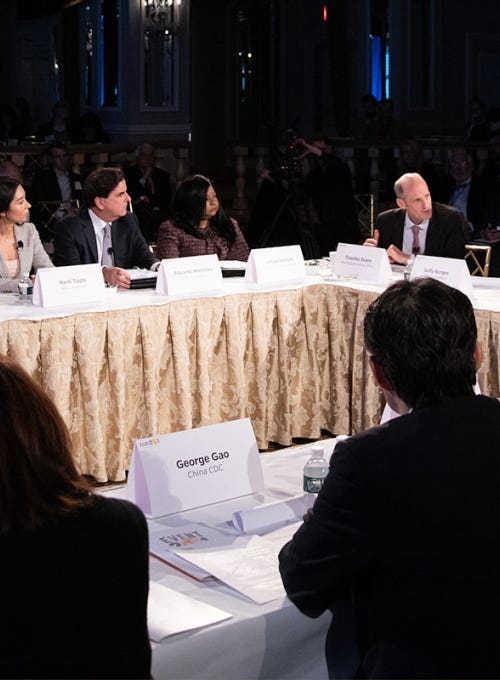The countertruth is in the beginning of a new development, often more important than the truth. The truth will be the firmer and sounder, the better comprehended is the countertruth. And in order to find the countertruth, one must be able to “advocate the devil,” to identify with the enemy, to feel like the lout. 1
Wilhelm Reich, The Murder of Christ: The Emotional Plague of Mankind
THE VIRTUALIZATION OF “WAR”
We live in a world where there is more and more information, and less and less meaning. 2
—Jean Baudrillard, Simulacra and Simulation
A few years ago, I read several books written by the French sociologist Jean Baudrillard, e.g., Simulacra and Simulation, America, The Illusion of the End, etc. Much of Baudrillard’s writing was over my head, but a few things stuck. His book about the media coverage and narratives of the 1991 Gulf War is profound. The Gulf War Did Not Take Place is a collection of three short essays. The title of the book is not literal: he does not mean that there wasn’t a military conflict in Kuwait and Iraq.
At the close of the 20th century, Baudrillard wrote about the acceleration of this global system of deterrence. At the time, 24-hour news coverage was a new thing, e.g., the Gulf War. The politics of fear via infinite information pacifies us into inert bodies in front of screens. The irony is that the faster this system accelerates the more we de-mobilize:
The masses themselves are caught up in a gigantic process of inertia through acceleration. 3
The 21st century is marked by the virtualization of all aspects of life on planet earth. Predating social media, Baudrillard’s final analysis is that “YOU are information, you are the social, you are the event, you are involved, you have the word, etc.” You are the center of the universe. The aim of the global system is consensus and obedience to specific narratives based on the active engagement of your subjective opinion. The acceleration toward the immediacy of total coverage for the event leads the individual to capture the false narratives, but also aspects of the truth.
To the extent there is a “system,” the function is to deter us from imagining—let alone creating—new global, political-economic systems. For example, western media never discusses Islamic finance. As opposed to Wall Street’s casino capitalism, Islamic finance requires capital investment be tied to real things. The constant cries of “Communist China” is a never-ending echo of our political discourse. However, China has merged aspects of state capitalism with communism (capi-communism), which is working okay for those 800 million citizens who were previously living in poverty. The question is, how does this global capitalist system operationalize “deterrence”?
DETERRENCE & COUNTERTRUTH
Deterrence is a very peculiar form of action: it is what causes something not to take place. 4
—Jean Baudrillard, The Illusion of the End
For Baudrillard, the instantiation of the global technological system functions to reify the system, i.e., maintain the status quo. What is this global “system”? In the book Simulacra and Simulation he describes it as “the universalization of a system of deterrence.” Deterrence is defined as an act, process, or communication that instills fear to prevent action or response. As opposed to critical thinking and positive transformation, deterrence is a negative motivational influence. A military attack on an enemy could be a deterrence (punishment) to discourage further attacks. A shock collar on a dog is used to deter the dog from a behavioral response that is problematic. A parent slapping their child across the face for running into the street is an act of deterrence. In the moment, neither the soldier, dog, nor the small child “know” how it is they are being deterred.
Jean Baudrillard was pointing to what Wilhelm Reich, MD called countertruth. Reich suggested that the “truth of your enemy is the countertruth to your own truth.” Writing in the 1950s, Reich used the example of a wife who had very rational reasons to engage with another lover. For example, the marriage with her husband had run its course or the husband was abusive or impotent. The wife’s concealment of the relationship hides the countertruth: if the affair is revealed, the husband will kill his wife or kill her lover (or both):
The lie in this case hides a serious countertruth: If the husband knew, he would kill her or her lover, or both. Nobody would be served. The countertruth is, in regard to telling the truth in this case, more powerful than the truth. 5
Returning to the constant news and video coverage of the 1991 Gulf War, the lie that it was a “war” hides the countertruth: it was a virtualized spectacle of violence and propaganda defined as “war.” The “battle” was Iraq versus a 42-country coalition led by the most advanced military ever to exist. Let us remember that Iraq had been allied with Russia and supported Palestinian resistance movements. What was the truth of the enemy (Saddam Hussein)? Was it an anti-imperial perspective? The media ensures that we never find out.
THE COVID PANDEMIC DID NOT TAKE PLACE
There are two forms of forgetting: on the one hand, the slow or violent extermination of memory, on the other, the spectacular promotion of a phenomenon, shifting it from historical space into the sphere of advertising, the media becoming the site of a temporal strategy of prestige … This is how we have manufactured for ourselves, with great swathes of promotional images, a synthetic memory which serves as our primal reference, our founding myth, and which, most importantly, absolves us of the real event of Revolution. 6
—Jean Baudrillard, The Illusion of the End
The 1991 Gulf War was a message of deterrence for those living outside of U.S. global hegemony. Specifically, the message was loud and clear to the Muslim world. In the U.S., the citizens became permanent audience members—or bystanding customers—to violence and war. This desensitization to violence erodes empathy and therefore is a form of deterrence. The psychological conditioning results in an overall form of emotional pacification. The truth that wars are actions taken by nation-states to punish their enemy does not get to the countertruth:
The weapon of truth requires that questions are asked regardless of whether they are liked or not, no matter what the results. If your most bitter enemy states falsehoods, you must find the falsehoods. If he states truth, you must find that he speaks the truth, no matter how painful the truth of your foe. 7
The Covid pandemic saw nation-states utilize various degrees of emergency measures to create an enclosed symbiosis with the citizenry: more consumers and content (data) for corporate and medical platforms that the state had access to for social control. But it was more sinister than that: the Covid event changed the psychological interiority of people. Security, surveillance, and self-tracking merged with “safety” and “health.” The real threat was Others. Globalization had eliminated physical boundaries and facilitated diversity of cultures to consumers. However, the pandemic reversed this course. Life was reduced to survivability via statistical methods, e.g., “flattening the curve,” and the fear of the Other (foreign) returned.
To use a dichotomy that has little application at this point, the “right” in the U.S. was suspicious and aggressive against the establishment narrative on Covid. They were vocal against the lockdowns and resisted mandates. Much of the populist right balked at the new experimental genetic therapies (mRNA “vaccines”) and “did their own research,” e.g., Ivermectin, exercise, and increased sunlight. The right feared a loss of autonomy, but their mobilizations against Covid were trivial. On a relational level, most played Kick Me (“MAGA! [wearing red Trump hat]”), Ain’t It Awful (Big Pharma or Censorship) and Gender Identity (“What is a woman?”) for attention.
Most of the so-called “left” welcomed mandates: social distancing, masking, vaccines, lockdowns (especially if they watch MSNBC) were a sense of relief. My Buddhist friends developed virtual sangha and conducted meditation retreats via Zoom. Based on fear, all of us over-adapted to Big Tech’s push for virtualization. The liberals/left believed people who focused on China as the culprit (“lab leak theory”) were racist and nativistic. Homeland security became a trusted enemy based on their study of white supremacy. Many played Ain’t It Awful (Trump) and Status Update (“Curbing the spread” and “Flattening the curve”) or “Addict” (Booze and THC lip balms) and Mental Health. Few called for revolution and instead submitted to adaptation.
All of us failed to understand the truth of our “enemy” during Covid. The right believed that authoritarians were wielding their power—through emergency orders and declarations—to suspend constitutional liberties. In their minds, mandates and lockdowns threatened small businesses and these policies would put the U.S. on a path to totalitarianism. They fear full participatory democracy (“Socialism!”) in favor of the status quo (neoliberalism). The conservative views Others as inferior. They may not say it in public, but they believe their sense of moral and intellectual understanding is superior to the masses. On the psychological level, this translates to don’t trust outsiders (nativism). The right always aims to sit next to the king, so they will never support and advance revolution.
Wilhelm Reich, MD searched for the countertruth of Nazi fascism. He wondered why it was that millions of Germans in the 1930s followed a psychopathic leader. His conclusion was based on an understanding of Hitler’s “truth” that the demagog shouted about the German economy, Marxism, Jews, the Weimar Republic, etc. Reich did not believe that it was the Hitlers and Stalins who hypnotized the people. It was the reverse: those masses of people brought the Hitlers and Stalins to power. The countertruth Reich realized was that fascism existed within the masses of people (a new development).
With this understanding of human nature as it applies to “Covid,” we realize a countertruth: human beings fear their own freedom. Our abreaction to fear is to now stay in place. Humans can immobilize themselves due to fear. The body becomes dead. Therefore, do not identify with “the right” or “the left” or any political group for that matter. U.S. corporate and oligarchic interest (profits) are in command. The elites want us to be afraid of and hate one another.
A RETURN TO THE IMMUNOLOGICAL AGE
Experience involves encountering the Other. It alters. 8
—Byung-Chul Han, The Burnout Society
The Burnout Society was published five years prior to the start of the pandemic. In the opening of the book, Han (2015) describes the 20th century as an “immunological age.” 9 He writes that that era was dominated by the fear of the Other (e.g., Cold War). The Otherness of the Other was met with combativeness and had to be fought off:
…everything foreign is simply combated and warded off. The object of immune defense is the foreign as such. Even if it has no hostile intentions, even if it poses no danger, it is eliminated on the basis of its Otherness. 10
Han (2015) wrote that Otherness was no longer the driver in the 21st century. He reported that “difference” is embraced versus attacked and guarded against. Globalization welcomes a sense of difference, opens borders, and offers a hybridization of cultures and people for “universal change and exchange.” 11 He wrote that the immunological age was now incompatible with the new era where everyone is the Same:
Immunological defense always takes aim at the Other or the foreign in the strong sense. The Same does not lead to the formation of antibodies. In a system dominated by the Same, it is meaningless to strengthen defense mechanisms. 12
Han (2015) was wrong about the end of an immunological era. The response to the Covid pandemic was a reversal: societies returned to the immunological age of the 20th century fears and scapegoating, e.g., Jews, communists, “illegal immigrants”. Social distancing and quarantine were necessary to avoid the Otherness of the virus. Inoculation and elimination of the mysterious contaminant meant walling off international travel and overall weariness of migrants (foreign). Nations regressed to hermetically sealed fortresses that disallowed Otherness. The introduction of fragments of a virus to provoke an immune reaction (e.g., flu vaccine) is the same as the relational process: aspects of the Other are introduced into one’s Own to eliminate Otherness, which provokes an emotional form of “immunoreaction.” 13Instead, self-deterrence was employed to distance oneself from the Other. People became more egocentric as identity was concretized.
Authoritarian measures such as “vaccine” (mRNA) mandates were promoted with false information, e.g., the vaccine stopped the spread and inoculated oneself from the virus. This new type of vaccine transfected the person with a synthetic RNA. The push for this was based on misuse of the term. A “vaccine” now included an experimental gene therapy whereby the body was treated as a machine. The new “vaccine” did not introduce a fragment of the virus to provoke an immune reaction of antibodies. It was akin to a computer program that wrote a new code to hack the body. The mRNA was a simulacra—copy without the original—of the virus. The immune system understood the body to be infected without the Otherness of the virus. The mRNA technology reprogrammed the existing cells (not introducing Other) to make a foreign protein to stimulate an adaptive immune response Therefore, if you did not welcome the mandated technology for this intervention, one was labeled an “antivaxxer.”
This is all consistent with a global system of deterrence: Otherness is view as dangerous and the proper response is to hide or ward off the Other due to fears of foreign contamination. In 2020, masks and at-home kits were disseminated for protection. At-home medical self-testing became normalized. Quarantine and disassembly of people using the virtual world were welcomed in the name of “survival” and “stopping the spread.” The concept of herd immunity—spreading the illness through young and healthy people to strengthen immune systems and to weaken the virus—were mocked by the media, elites, and the professional managerial classes. The result was various political orientations across online platforms calling for the expulsion of the Other. Empathy toward difference was no longer welcomed. Instead, sequestration from the Other was required and performative virtual diatribes (self-exhibition) resulted in less bodily exchange of information:
The digital order causes an increasing disembodiment of the world; today, there is less and less communication between bodies. 14
NEUROTIC SOCIALITY & MASS FORMATION
The need to control is closely related to the fear of being controlled. 15
—Alexander Lowen, Bioenergetics
Berardi (2024) describes how during the pandemic, “responsibility and caution”16 were heightened, which made physical proximity with others “less frequent, hesitant, and neurotic.” 17 The collective Freudian “superego” became supercharged: the global citizen told themselves to be moralistically inhibited from sociality. The political and technological push was for virtual and not bodily connection. The internet separates “desire from pleasure” and establishes “a cycle of excitement detached from the pleasure of physical conjunction.”18
The pandemic also deployed a psycho-mutation process: a phobic awareness of the other’s body that favors, indeed even urges, social distancing. The technologies that make such a distancing possible have spread over the lived time of the generation that defines itself as the last.19
An inner compulsion toward compliance, obedience, transparency, and reliance on “the experts” was driven by the politics of fear much like the American “war on terror” achieved. Berardi (2024) adds that the pandemic “fully mobilized remote communication technology, increasing the social mind’s dependence on the screen and digital, contactless hyper-stimulation.” 20The body merged with the machine not by dictatorial decree. The individual felt an inner compulsion to share themselves online. The result was the total transparency of the private self. Sickness or unhealth was required to become public knowledge (vaccine passports) for control and warding off the virus versus private knowledge (confidentiality) to be decided upon by the individual outside of the dominant narrative (using intuition).
The transhumanist movement gained momentum based on an internal desire of the individual to “merge physically and mentally with machines.” In The Psychology of Totalitarianism, professor of clinical psychology Mattias Desmet states that the aim of transhumanists is “to replace the chaos of writhing bodies with a strictly technological internet of bodies.” 21 Isolation and over-dependence on technological tracking, self-measurement, medical testing, and alerts have permanently altered society. The perception during the Covid pandemic was that social distancing, remote work, and “distance learning” were altruistic. What was missed was the giant power grab by the global capitalist elites.
Despite the largest upward transformation of wealth to the billionaire class, the consequence was not an increase in class antagonism. Instead, minor differences of opinions on the virus were merged with political affiliation to resurge cultural antagonisms, e.g., hating your neighbor for wearing a mask (or not), isolation from the Other, or vaccinating one’s children (or not), etc. The system of deterrence was turbocharged while tech oligarchs spawned.
Why the need to accelerate the system of deterrence at the start of 2020? Recall, at the end of 2019 and into 2020, the world was on fire with massive protests and mobilizations, e.g., Hong Kong, Iran, France, U.S. (Black Lives Matter), Canada (truckers), etc. In the west, elites had known the scientific projection for “excess deaths” in the coming five years. Instead of Medicare For All, simulations were conducted. Tabletop exercises for pandemics and potential responses were underway in October of 2019. This included the infamous “public-private” (neoliberalism) partnership idea pushed by the Bill and Melinda Gates Foundation.
BE THE DEVIL’S ADVOCATE
We live in a community of people not so that we can suppress and dominate each other or make each other miserable but so that we can better and more reliably satisfy all life’s healthy needs. 22
—Wilhelm Reich, Children of the Future
Each of us wholeheartedly believes our subjective experience of the Covid pandemic is the right view. In contrast with Baudrillard’s book title and thesis on the 1991 Gulf War, I do not think that the Covid-19 virus took place. There was no singular virus with contingency across time and space. My guess is there were many viruses deployed by various interests. I do not doubt that beginning in 2020 people were very sick and unfortunately died during the “Covid pandemic” (from various illnesses including corona viruses). I will not explain my rationale for this position. Perhaps in a part II to this article. I offer the position only for those who think the same thing and have kept that hidden in the recesses of their minds.
We must realize the truth of the Other (enemy) to empathize and comprehend the countertruth, which contains the truth. Do not define yourself as a “self,” which is a manifestation of the system. Suspend the notion of “self,” so you are not defined by the system. Actively engage in subverting the system itself. 23
Therefore, when someone says, “During Covid when everything was locked down…” tell them that “The Covid Pandemic Did Not Take Place.” You will witness the emergence of rigid defensiveness. The person will protect their “truth” about Covid whatever it is. Listen. They will say they “know” what they experienced was “real.” In response to questioning the system, you will be called a “conspiracy theorist” and “right-wing,” or worse, “crazy.” Be the devil’s advocate to create something new:
The countertruth is in the beginning of a new development, often more important than the truth. The truth will be the firmer and sounder, the better comprehended is the countertruth. And in order to find the countertruth, one must be able to “advocate the devil,” to identify with the enemy, to feel like the lout. 24
POSTSCRIPT


References
p. 202, Reich, W. (1953). The murder of Christ: The emotional plague of mankind. The Noonday Press a division of Farrar, Straus, Giroux: New York. (orig. written in 1951)
p. 79, Baudrillard, J., & Glaser, S. F. (1994). Simulacra and simulation. Ann Arbor: University of Michigan Press.
p. 161, Baudrillard, J., & Glaser, S. F. (1994). Simulacra and simulation. Ann Arbor: University of Michigan Press.
p. 17, Baudrillard, J. (1994), translation by Chris Turner. The illusion of the end. California: Stanford University Press.
p. 201, Reich, W. (1953). The murder of Christ: The emotional plague of mankind. The Noonday Press a division of Farrar, Straus, Giroux: New York. (orig. written in 1951)
p. 23, Baudrillard, J. (1994), translation by Chris Turner. The illusion of the end. California: Stanford University Press.
p. 202, Reich, W. (1953). The murder of Christ: The emotional plague of mankind. The Noonday Press a division of Farrar, Straus, Giroux: New York. (orig. written in 1951)
p. 39, Han, B.C. (2015). The burnout society. Stanford Briefs: Stanford, CA.
p. 1, Han, B.C. (2015). The burnout society. Stanford Briefs: Stanford, CA.
p. 2, Han, B.C. (2015). The burnout society. Stanford Briefs: Stanford, CA.
p. 3, Han, B.C. (2015). The burnout society. Stanford Briefs: Stanford, CA.
p. 4-5, Han, B.C. (2015). The burnout society. Stanford Briefs: Stanford, CA.
p. 4, Han, B.C. (2015). The burnout society. Stanford Briefs: Stanford, CA.
p. 42, Han, B.C. (2018). The expulsion of the other. Polity Press: Medford, MA.
p., 161,Lowen, A. (1975). Bioenergetics. Penguin Compass: New York.
p. 66, Berardi, F. (2024). Quit everything: Interpreting depression. London: Repeater.
p. 48, Berardi, F. (2024). Quit everything: Interpreting depression. London: Repeater.
p. 48, Berardi, F. (2024). Quit everything: Interpreting depression. London: Repeater.
p. 66, Berardi, F. (2024). Quit everything: Interpreting depression. London: Repeater.
p. 46, Berardi, F. (2024). Quit everything: Interpreting depression. London: Repeater.
Desmet, M. (2021). The psychology of totalitarianism. Translated by Els Vanbrabant. Chelsea Green Publishing: Vermont.
p. 221, Reich, W. (1983). Children of the future: On the prevention of sexual pathology. Translations by Dereke and Inge Jordan and Beverly Placzek. Edited by Mary Higgins and Chester M. Raphael, MD. Farrar, Straus, Giroux: New York. (originally published in 1950 by Orgone Institute Press).
This is in reference to two system (Taoism and Zen) that are systemless. “[Taoism and Zen] are two expressions of the same system of thought that is actively engaged in subverting itself. Ultimately, they are not about the system that defines them.” p. 274 of Grigg, R. (1994). The Tao of Zen. Charles E. Tuttle Co, Inc.: Boston.
p. 202, Reich, W. (1953). The murder of Christ: The emotional plague of mankind. The Noonday Press a division of Farrar, Straus, Giroux: New York. (orig. written in 1951)










